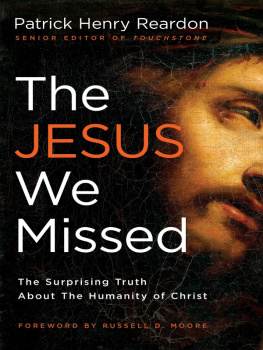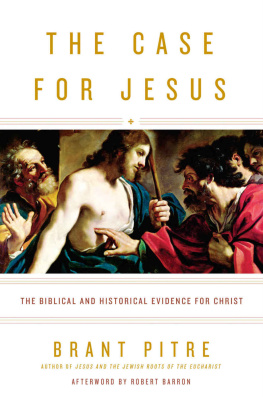
The
JESUS
We Missed
OTHER BOOKS BY PATRICK HENRY REARDON:
Christ in the Psalms
Christ in His Saints
The Trial of Job
Chronicles of History and Worship
Creation and the Patriarchal Histories
Wise Lives
The
JESUS
We Missed
THE SURPRISING TRUTH
ABOUT THE HUMANITY OF CHRIST
PATRICK HENRY REARDON

2012 by Patrick Henry Reardon
All rights reserved. No portion of this book may be reproduced, stored in a retrieval system, or transmitted in any form or by any meanselectronic, mechanical, photocopy, recording, scanning, or otherexcept for brief quotations in critical reviews or articles, without the prior written permission of the publisher.
Published in Nashville, Tennessee, by Thomas Nelson. Thomas Nelson is a registered trademark of Thomas Nelson, Inc.
Thomas Nelson, Inc., titles may be purchased in bulk for educational, business, fund-raising, or sales promotional use. For information, please e-mail SpecialMarkets@ThomasNelson.com.
Unless otherwise noted, Scripture quotations are the authors translation.
Scripture quotations marked NKJV are from THE NEW KING JAMES VERSION. 1982 by Thomas Nelson, Inc. Used by permission. All rights reserved.
Library of Congress Cataloguing-in-Publication Data
Reardon, Patrick Henry, 1938
The Jesus we missed : the surprising truth about the humanity of Christ / Patrick Henry Reardon.
p. cm.
Includes bibliographical references and index.
ISBN 978-1-59555-371-3
1. Jesus ChristBiography. I. Title.
BT301.3.R42 2012
232'.8dc2
2011024313
Printed in the United States of America
12 13 14 15 16 QGF 6 5 4 3 2 1
MULIERI QUAM
ADIUTOREM MIHI SIMILEM
DEDIT DEUS
CONTENTS
by Russell D. Moore
by Russell D. Moore
SEVERAL YEARS AGO, A BRUTAL STOMACH VIRUS CREPT through the seminary community where I serve as dean. One day, knowing that most of the students in my classroom were on the upswing from this sickness, I posed the question, Did Jesus ever have a stomach virus?
On a more typical daya day in which the question of such illness would have been a more abstract realityI doubt there would have been anything less than consensus. Of course, these future pastors would have asserted, Jesus assumed everything about human nature, except for sin.
But this wasnt an abstract question. These students were still reeling not just from the discomfort of the stomach flu but also from its indignity. They had been wracked with vomiting, diarrhea, fever, and chills. They still smarted from the sense of having no control over the most disgusting of bodily functions.
So when I asked this question, these ministers of the gospel hesitated. The stomach virus wasnt just awful; it was undignified. And thinking of Jesus in relation to the most foul and embarrassing aspects of bodily existence seemed to them to be just on the verge of disrespectful, if not blasphemous.
x
Why is it so hard for us to imagine Jesus vomiting?
The answer to this question has to do, first of all, with the one-dimensional picture of Jesus so many of us have been taught or have assumed. Many of us see Jesus either as the ghostly friend in the corner of our hearts, promising us heaven and guiding us through difficulty, or we see him simply in terms of his sovereignty and power, in terms of his distance from us. No matter how orthodox our doctrine, we all tend to think of Jesus as a strange and ghostly figure.
But the bridging of this distance is precisely at the heart of the scandal of the gospel itself. It just doesnt seem right to us to imagine Jesus feverish or vomiting or crying in a feeding trough or studying to learn his Hebrew. From the very beginning of the Christian era, those who sought to redefine the gospel argued that it doesnt seem right to think of Jesus as really flesh and bone, filled with blood and intestines and urine. It doesnt seem right to think of Jesus as growing in wisdom and knowledge, as Luke tells us he did. Somehow such things seem to us to detract from his deity, from his dignity.
But thats just the point.
The very beginning of the Christ story itself tells us that part of the sign of the Messiah is that he is wrapped in cloths (Luke 2:12). Why do you wrap cloths around a baby? For the same reason you might diaper your infant or wrap her up in a blanket. The point is to keep the baby warm and to keep him dry from waste. From the very beginning Jesus is one of us, sharing with us a human nervous system, a human digestive system, and as well see every aspect of human nature.
It didnt seem right to the world to imagine the only begotten of the Father twisting in pain on a crucifixion stake, screaming as he drowned in his own blood. This was humiliating, undignified. Thats just the point. Jesus joined us in our humiliation, our indignity. In this Jesus is, the Scripture tells us, not ashamed to call us brothers (Hebrews 2:11).
xi
The book you hold in your hand (or see on your screen, as the case may be) is the best treatment of the humanity of our Lord Jesus that Ive ever encountered. Patrick Henry Reardon is one of the most Bible-saturated, Christ-intoxicated writers and preachers Ive ever met, and I believe this is his finest work.
This book prompted me to think and to ponder. But, more than that, this book prompted me to pray and to worship, to see the Jesus it is so easy for me to forget: the Jesus who was really and truly one of us, so that we might be, with him, the heirs of the Father and the children of God. The one who took on every aspect of our flesh and blood in order to redeem us from the power of the devil (Hebrews 2:1415).
As you read this book, I pray that youll be driven toward the Jesus you might have missed. I pray also that youll see something of what youve missed about your own humanity. Too often, were tempted to excuse our own bitterness, our rage, our lust, our envy, our factiousness as only human. The mystery of Christ shows us that such things arent human at all, but satanic. We define humanity in light of our brother, in light of the alpha and omega point of humanityJesus of Nazareth.
This book will drive you to the Jesus you might have forgotten or might never have seen. It will also propel you with longingfor the day spike-scabbed hands wipe away your tears as you hear a northern Galilean accent introduce himself as your Lord, as your King, but also as your brother.
xiii
THE ATTENTIVE READER OF THE FOUR GOSPELS MAY NOTICE that they all containnot too far into the storya special scene in which Jesus inaugurates his teaching ministry. Those first formal sermons of Jesusdifferent in each of the Gospelsare preceded by other accounts of his activity, particularly of his miracles. Each inaugural sermon, moreover, introduces themes important to the Evangelists. In addition, as the narrative sequence shifts from Jesus other activity to the beginning of his teaching ministry, the relevant scene is introduced with a certain degree of solemnity, depending on the style favored by the Evangelist.
In Marks gospel, for instance, after three chapters describing Jesus other activities, the Evangelist slows the narrative pace in order to introduce the first sermon in dramatic detail. Mark writes,
And again he began to teach by the sea. And a great multitude was gathered to him, so that he climbed into a boat and sat on the sea; and the whole multitude was on the land facing the sea. Then he taught them many things by parables. (Mark 4:12)
Next page











